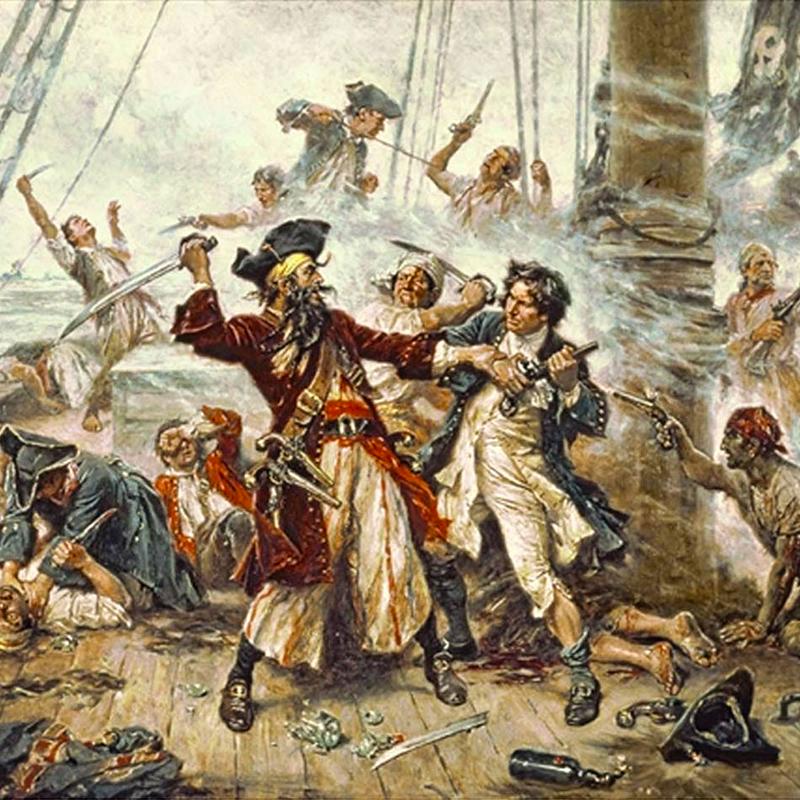Pirates of the Galapagos
By Karen Harris | January 12, 2023

Thanks to Johnny Depp, we tend to associate pirates with the Caribbean, but pirates operated all around the world’s oceans, including the Galapagos Islands. This group of isolated volcanic islands is in the Pacific Ocean, roughly 600 miles west of Ecuador. Here is the story of the pirates of the Galapagos.
The Unique Galapagos Islands
The Galapagos Islands are a unique cluster of islands in the Pacific Ocean. They are home to diverse and unusual plant and animal species that are unlike any others on earth. The islands were first discovered by Europeans in 1535 and were later visited by naturalist Charles Darwin in 1835. His observations and research on the island’s flora and fauna during his five-week visit contributed to his theory of evolution by natural selection.

A Pirate Hideout
Since the 17th century, pirates made use of the remoteness of the Galapagos Islands for their own advantage. This ramped up in the 1800s. The seafaring criminals targeted ships in the nearby shipping lanes. Between raids, the pirates often stopped at the islands to rest and resupply before continuing their raids. The Galapagos Islands were ideal for several reasons. One of the main reasons was the abundant marine life in the waters around the islands. Whaling, seal hunting, and turtle hunting were all popular industries in the Galapagos in the 19th century, and the pirates would often prey on the ships engaged in these industries. Additionally, the Galapagos were also a popular stopover point for ships traveling between South America and the Western coast of North America and Asia. It was a perfect place for pirates to lie in wait and attack passing ships.
Treasure Islands?
The Galapagos Islands were also attractive to pirates because their remoteness from the mainland meant there was a lack of law enforcement in the area. Pirates could hide out there, repair their ships, and resupply their storerooms, while feeling relatively safe from capture by the authorities. If the legends are to be believed, the pirates also took advantage of the uninhabited island to bury their treasure.
Easy Pickings
The Galapagos Islands are situated in a spot with strong winds and treacherous currents. Many ships that passed the islands got caught in these currents and were shipwrecked on the rocky islands. It was easy for the pirates to pick and loot shipwrecks.

Pirates Versus Privateers
We should note that many of the Galapagos pirates were not technically pirates. They were privateers. The line between the two is a bit blurry as the privateers were basically state-sanctioned pirates. They carried with them letters of marque from their government that granted them permission to attack and capture ships belonging to nations with whom their countries were at war. But the looting and pillaging remained the same.
Who Were Some of the Pirates of the Galapagos?
Some of the most famous pirates known to have operated in the waters around the Galapagos Islands include Ambrose Cowley, Benito Bonito, James Colnett, and John C. Williams. Ambrose Crowley visited the Galapagos Islands in 1684 and wrote descriptions of the animals on the islands. Those descriptions caught the attention of other Europeans. Benito Bonito, an Italian pirate of the early 19th century, earned a reputation for attacking whaling ships around the Galapagos. James Colnett was an English naval officer and explorer. After he was captured by the Spanish in 1789, he was forced to work as a pirate in the Galapagos and the Pacific coast of South America. John C. Williams was an American privateer who led one of the most successful pirate raids in the Galapagos. The last reported pirate attack in the Galapagos was in 1906.